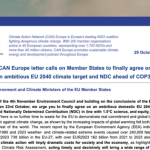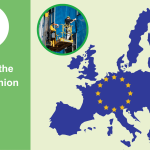In light of the Commission’s recent Assessment report of the draft updated National Energy and Climate Plans (NECPs) and the Commission’s ongoing bilateral discussions with Member States, we (undersigned: the Together for 1.5 Consortium, 14 civil society organisations from across Europe) would like to express our concerns regarding the NECP revision process. In line with the ESABCC’s key recommendation, we urge the Commission to intensify its efforts and – if necessary – employ enforcement measures to decisively prompt Member States to address the shortcomings of the NECPs.
The final NECPs should not only fully comply with the Governance Regulation in terms of content and process, but also fully reflect EU’s new legislative framework and demonstrate sufficient ambition to enable achievement of the EU’s energy and climate objectives and the Paris Agreement.
Compliance with EU law
We share the concerns of the Commission regarding the alarming fact that the draft NECPs are falling short of meeting the EU’s 2030 climate and energy targets – as stipulated in Article 4 of the European Climate Law. Consequently, they are clearly insufficient to enable the collective achievement of the EU’s climate-neutrality objective. Both the Commission and the Member States are obligated, under Article 2(2) of the EU climate Law, to take the necessary measures to achieve the climate-neutrality target.
NGOs have already expressed their serious concerns regarding the state of the NECPs and their lack of ambition to be in line with the Paris Agreement. To deliver its fair and science-based share under the Paris Agreement, the EU must reduce its gross emissions by at least 65% by 2030. The current ambition would also leave no room for the development of a new EU-wide NDC that reflects the EU’s highest possible ambition. In their recent progress report, the European Scientific Advisory Board on Climate Change (ESABCC) calls on Member States to “urgently adopt and implement national measures to increase the pace of emissions reductions…” making explicit reference to the NECPs in that regard.
All these voices clearly align in confirming that Member States must increase their ambition and implement significant improvements before the final submission of NECPs in June 2024.
Public consultation and multi-level dialogues
Another major flaw of the NECP process is that the participation process in most Member States did not comply with the requirements of Art 10 and Art 11 of the Governance Regulation, nor the Aarhus Convention.
While the Commission’s Assessment rightly identifies these shortcomings, it does not consistently translate them into strong requirements and calls to action to the Member States. This approach risks that Member States may not take the necessary measures to fulfil their obligations until the final deadline.
As the window to deliver on the EU and Paris Agreement commitments until 2030 is rapidly shrinking, we urge the Commission to translate all the concerns highlighted in the EU-wide NECP assessment into explicit expectations that Member States cannot disregard. During the dialogue with Member States, the Commission should ensure that governments utilise NECPs as originally intended – as a strategic tool to close policy gaps and take prompt, decisive action.
Attached to this letter, we present additional concerns and recommendations for your careful consideration during the NECP iteration process with Member States.
ANNEX
NGO considerations following the Commission’s latest NECP assessment report
- Increased ambition beyond the EU targets – Commission Recommendations towards Member States should make it clear that NECPs must aim to fully meet the ambition of the new EU’s legislation in its entirety (relating to climate, energy and RRP). To comply with Paris obligations, the EU must next year submit a new NDC that “reflect its highest possible ambition” – Therefore the current EU targets reflect the minimum ambition level.
- Additional measures – Member States need to include additional policies and measures (PAMs) that allow them to reach targets and obligations. According to the Governance Regulation the NECPs shall include not only the WEM scenario but also the WAM scenarios”. However, in its assessment of draft NECPs (many with missing or insufficient WAM-chapters) the Commission did not always point to this legal requirement. WAM scenarios are often missing, not credible or not aligned with additional PAMs in some of the new draft NECPs.
It is particularly important that the additional measures that require new funding are identified. The Commission should ensure that the final NECP updates contain sufficient WAM-scenarios and also that investment gaps are revealed. - Coal phase-out plans are delayed or missing – It is very problematic that some Member States are backtracking on previous commitments and delaying coal phaseout as well as failing to include a timeline for ending national fossil fuel subsidies.
- Ensuring a just transition – To accompany the needed acceleration in climate measures, Member States need to systematically assess potential social risks and mitigate them early on. Most Member States did not respect the Governance Regulation’s mandate to assess the level of energy poverty and potentially to include an associated reduction target. Member States also scarcely mentioned transport poverty. Therefore the NECPs do not lay a solid ground for the upcoming Social Climate Plans and for addressing the social outcomes of the upcoming ETS-2. This poses clear social risks that should be made very clear to Member States.
- EU funds and additional emissions’ reduction – The final NECP updates must account for the additional measures and the related emissions’ reductions made possible by the use of EU funds, notably the Recovery and Resilience Facility (RRF) and REPowerEU. This is not optional: Member States are legally required to spend 37% of their RRF funding on the green transition, and the NECPs cannot truly be considered as “integrated” plans if such crucial pieces of the puzzle are not properly accounted for. The Commission needs to ensure that final NECPs include a quantification of emissions’ reductions generated by RRF and REPowerEU funding, and that Member States increase their national targets accordingly.



